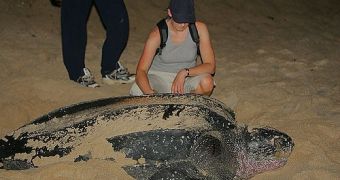Groundbreaking research using satellite tracking is what allowed, for the first time, the revealing of the ambitious journeys of the gigantic leatherback turtle in the South Atlantic.
This is the result of a five-year study, conducted by experts at the Center for Ecology and Conservation (Cornwall) at the University of Exeter, in an attempt to find out more about these increasingly rare creatures, for conservation efforts.
Not much was known about the migration behavior of these animals, only that they moved from the world's largest breeding colony in Gabon, Central Africa, to their feeding grounds across the South Atlantic.
Leatherbacks are the largest turtles on Earth, growing up to 7 feet (2 meters) long and exceeding 2,000 pounds (900 kilograms).
These are the only remaining representatives of a family of turtles that traces its evolutionary roots over 100 million years ago.
The leatherback turtle populations once lived in every ocean, except for the Arctic and Antarctic, nut now, they are rapidly declining in many parts of the world.
Over the past 30 years, leatherback turtles have been rapidly declining in the Pacific ocean – one nesting colony in Mexico declining from 70,000 in 1982 to just 250 by 1998-1999.
In the Atlantic, population levels have been more resilient but, because of variations in numbers at nesting sites each year, it's not really clear whether they are in decline, or not.
What is certain is that conservationists are prepared and eager to take action now to avoid a repeat of the Pacific story, where even if the exact cause of the decrease is unknown, turtle egg harvesting, coastal gillnet fishing and longline fishing have been established as potential factors.
This new research studied 25 females, and 3 migratory routes, including one of 7,563km (4,699 mile) long, straight across the South Atlantic from Africa to South America.
The other two routes showed turtles moving from Gabon to food-rich habitats in the southwest and southeast Atlantic and off the coast of Central Africa.
The researchers said that the leatherbacks will stay in these areas over a 2 to 5 year period, the time to build up the reserves to reproduce, and then return to Gabon once again.
“Despite extensive research carried out on leatherbacks, no-one has really been sure about the journeys they take in the South Atlantic until now,” said Dr Matthew Witt.
“What we've shown is that there are three clear migration routes as they head back to feeding grounds after breeding in Gabon, although the numbers adopting each strategy varied each year.
“We don't know what influences that choice yet, but we do know these are truly remarkable journeys – with one female tracked for thousands of miles traveling in a straight line right across the Atlantic.”
“This important work shows that protecting leatherback turtles—the ancient mariners of our oceans—requires research and conservation on important nesting beaches, foraging areas and important areas of the high seas,” added Dr. Howard Rosenbaum, Director of the Wildlife Conservation Society's Ocean Giants Program.
“Armed with a better understanding of migration patterns and preferences for particular areas of the ocean, the conservation community can now work toward protecting leatherbacks at sea, which has been previously difficult.”
Finally, Dr Brendan Godley said “all of the routes we've identified take the leatherbacks through areas of high risk from fisheries, so there's a very real danger to the Atlantic population.”
The new research is proving vital for conservation strategies, because “knowing the routes has also helped us identify at least 11 nations who should be involved in conservation efforts, as well as those with long-distance fishing fleets.
“There's a concern that the turtles we tracked spent a long time on the High Seas, where it's very difficult to implement and manage conservation efforts, but hopefully this research will help inform future efforts to safeguard these fantastic creatures.”
The research has been carried out with support from Parcs Gabon, the Wildlife Conservation Society (WCS), PTMG (Marine Turtle Partnership for Gabon), the Trans-Atlantic Leatherback Conservation Initiative (TALCIN) - a multi-partner effort coordinated by WWF, and SEATURTLE.org
The results have been published in the Proceedings of the Royal Society B today, January 5, 2011.

 14 DAY TRIAL //
14 DAY TRIAL //